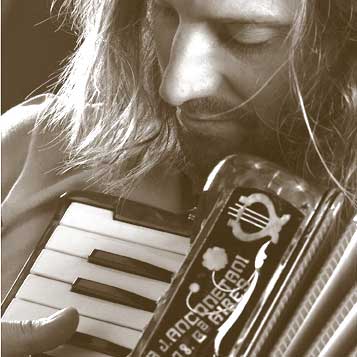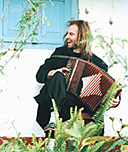

Chango Spasiuk: The Charm of Chamamé WW 601
home | cd's | artists | order |
 |
main | info (pdf) | press | |
||
|
BIOGRAPHY Spasiuk was born in 1968 in Misiones, a small province near the brazilian border. Its society is the product of a complex process of fusion and interaction between the disparate elements of its population: the original native communities (Mbya-Guaraní), the Creoles, and the foreign settlers who established themselves at the beginning of the 20th century. Among the latter were Ukranians, to whom Chango Spasiuk is intimately linked by virtue of his two Ukranian grandparents. Chango Spasiuk spent his childhood in a highly stimulating milieu. His childhood was centered around the carpenter's shop managed by Lucas, his violinist father, and Marcos, an uncle who sang. The singing duos playing in red earth patios, the unrelenting subtropical climate, a terrain of jungle and wide rivers, of labourers working with hoes and machetes on the yerba mate plantations - this is the world that underlies the powerful texture and mysticism of his music. He plays with a memory of the
informal rural polkas, performed by the whole familiy, that were
such a special feature of his home in Misiones. It is legacy and synthesis. |
 |
|
|
CHAMAMÉ Chamamé is a wild music. It comes from a wild environment, where rain forests, rivers and falls, hot temperatures and frequent rains keep man in a constant romance and struggle with nature. It is the northeast of Argentina, it is part of south Brazil. The senses are wide open in these lands, where Chamamé comes from. The colours are intense, the shapes are unique, the sounds of nature, of water falls, birds singing, rivers running, the textures of the land, every detail penetrates the human senses constantly - and that is in the music. The music expresses the constant fight between «joy and melancholy», because life exists between these extremes day after day. Hard work in the middle of such astonishing beauty, love, loneliness ! So Chamamé can be a
happy and sad music, at the same time, with as much feeling as
swing. Chamamé is mysterious, its name has not translation
or explanation, as The 6/8 rhythm of Chamamé evolved through three centuries, based on african roots but influencedby Creoles and the Guarany Indians, and further developed by European immigrants who brought with them the main instrument of the Chamamé - the accordeon. Now Chamamé often includes violin, percussion and bass. It is the most powerful folk expression of the north-eastern part of Argentina. |